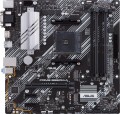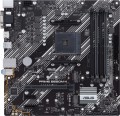Power phases
The number of processor power phases provided on the motherboard.
Very simplistically, phases can be described as electronic blocks of a special design, through which power is supplied to the processor. The task of such blocks is to optimize this power, in particular, to minimize power surges when the load on the processor changes. In general, the more phases, the lower the load on each of them, the more stable the power supply and the more durable the electronics of the board. And the more powerful the CPU and the more cores it has, the more phases it needs; this number increases even more if the processor is planned to be overclocked. For example, for a conventional quad-core chip, only four phases are often enough, and for an overclocked one, at least eight may be needed. It is because of this that powerful processors can have problems when used on inexpensive low-phase motherboards.
Detailed recommendations on choosing the number of phases for specific CPU series and models can be found in special sources (including the documentation for CPU itself). Here we note that with numerous phases on the motherboard (more than 8), some of them can be virtual. To do this, real electronic blocks are supplemented with doublers or even triplers, which, formally, increases the number of phases: for example, 12 claimed phases can represent 6 physical blocks with doublers. However, virtual phases are much inferior to real ones in terms of capabilities — in fact, t...hey are just additions that slightly improve the characteristics of real phases. So, let's say, in our example, it is more correct to speak not about twelve, but only about six (though improved) phases. These nuances must be specified when choosing a motherboard.
VRM heatsink
The design of the motherboard has a separate heatsink for VRM.
VRM is a voltage regulation module through which power from a computer power supply is supplied to the processor. This module steps down the standard power supply voltage (+5V or +12V) to a lower value required by the processor (usually just over 1V). At high loads, the voltage regulator can get very hot, and without a specialized cooling system, the matter can end with overheating and even burnout of parts. The VRM heatsink reduces the likelihood of such situations; it can be useful for any CPU, and highly desirable if the board is planned to be used with a powerful high-end processor (especially overclocked).
M.2 version
The version of the M.2 interface determines both the maximum data transfer rate and the supported devices that can be connected via physical M.2 connectors (see the corresponding paragraph).
The version of the M.2 interface in the specifications of motherboards is usually indicated by the number of connectors themselves and by the PCI-E revision provided for in each of them. For example, the entry “3x4.0” means three connectors capable of supporting PCI-E 4.0; and the designation “2x5.0, 1x4.0” means a trio of connectors, two of which support PCI-E 4.0, and another one supports PCI-E 5.0.
ARGB LED strip
Connector for connecting an addressable LED strip as a decorative lighting for a computer case. This type of "smart" tape is based on special LEDs, each of which consists of an LED light and a built-in controller, which allows you to flexibly control the luminosity using a special digital protocol and create amazing effects.
RGB LED strip
Connector for connecting a decorative LED strip and other devices with LED indication. Allows you to control the backlight of the case through the motherboard and customize the glow for your tasks, including synchronize it with other components.
USB 2.0
The number of USB 2.0 connectors installed on the back of the motherboard.
Recall that USB is the most popular modern connector for connecting various external peripherals — from keyboards and mice to specialized equipment. And USB 2.0 is the oldest version of this interface that is relevant today; it is noticeably inferior to the newer USB 3.2 both in terms of speed (up to 480 Mbps), and in terms of power supply and additional functionality. On the other hand, even such characteristics are often enough for undemanding peripherals (like the same keyboards / mice); and devices of newer versions can be connected to the connectors of this standard — there would be enough power supply. So this version of USB is still found in modern motherboards, although there are fewer and fewer new models with USB 2.0 connectors.
Note that in addition to the connectors on the rear panel, connectors on the board itself (more precisely, ports on the PC case connected to such connectors) can also provide a USB connection. See below for more on this.
USB 3.2 gen2
The number of native USB 3.2 gen2 connectors provided on the back of the motherboard. In this case, we mean traditional, full-size USB A ports.
USB 3.2 gen2(formerly known as USB 3.1 gen2 and simply USB 3.1) is the evolution of USB 3.2 after version 3.2 gen1 (see above). This standard provides connection speeds up to 10 Gbps, and to power external devices in such connectors, USB Power Delivery technology (see below) can be provided, which allows you to output up to 100 W per device (however, Power Delivery support is not mandatory, its presence should be specified separately). Traditionally for the USB standard, this interface is backwards compatible with previous versions — in other words, you can easily connect a device supporting USB 2.0 or 3.2 gen1 to this port (unless the speed will be limited by the capabilities of a slower version).
The more connectors provided in the design, the more peripheral devices can be connected to the motherboard without the use of additional equipment (USB splitters). In some models of motherboards, the number of ports of this type is
5 or even more. At the same time, we note that in addition to the connectors on the rear panel, connectors on the board itself (more precisely, ports on the case connected to such connectors) can also provide a USB connection. See below for more on this.
Fan power connectors
The number of connectors for powering coolers and fans provided in the motherboard. A processor cooler is usually connected to such a connector, and fans of other system components — video cards, cases, etc. can also be powered from the "motherboard"; sometimes it is more convenient than pulling power directly from the PSU (at least you can reduce the number of wires in the case). Many modern boards are equipped with
4 or more connectors of this type.
CPU Fan 4-pin
A four-pin connector used to connect a processor cooling fan. The first contact in it corresponds to the black wire of the cooler — it is the "ground" or minus of the power supply. The second contact is the plus of the power supply (yellow or red cooler wire). The third one is involved in measuring the rotation speed of the impeller (green or yellow fan wire). The fourth pin, corresponding to the blue wire, receives control signals from the PWM controller to adjust the cooler rotation speed depending on the temperature of the processor.

